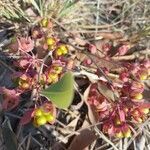Leaves petiolate; lamina 4–12·4 (16) ×1·2–3·7 cm., oblong or elliptic to oblanceolate or more rarely obovate, acute or mucronate to rounded at the apex, with margin densely ± curved-glandular-serrulate or more rarely entire, cuneate at the base, herbaceous to chartaceous, with primary lateral nerves ascending, interconnected by more widely spreading secondary laterals in turn linked by tertiary cross-veins, prominent above, plane below; petiole 1–4 (14) mm. long, rather stout, flat or grooved above.
Rhizomatous shrublet or shrub up to 1 (2) m. high, frequently flowering just above ground level, with bark brown, ± rough, flaking; branches striate, purplish with pale lenticels at first, becoming white or pale brown and then ± ferrugineous, with bark not usually exfoliating.
Flowers solitary or 1–4 in fascicles, often with several fascicles clustered together, at the base of current year’s shoots, appearing before the leaves; pedicels (0·9) 1·3–2·5 cm. long in fruit.
Sepals pink, 5–6 mm. long in flower, oblong, rounded, spreading or reflexed after flowering, becoming crimson-red, 8–10 mm. long, broadly oblong, flat and spreading or reflexed in fruit.
Stamens (13–19) 20 (21–22), with anthers yellow, 1·5–2 mm. long, 3/4–11/4 times as long as the filaments, straight, often twisting spirally after dehiscence.
Petals white, frequently tinged pink or with pink centre line, 6–8 mm. long, obovate to narrowly oblanceolate, narrowed at the base but not clawed.
Carpels 5–7, with styles completely united; stigma small, scarcely lobed.
Drupelets 6–8 × 6–7 mm., curved-lenticular, compressed.

